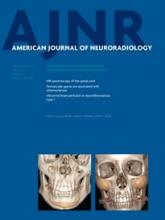Research ArticleNeurointervention
What Is Meant by “TICI”?
J.E. Fugate, A.M. Klunder and D.F. Kallmes
American Journal of Neuroradiology September 2013, 34 (9) 1792-1797; DOI: https://doi.org/10.3174/ajnr.A3496
J.E. Fugate
aFrom the Division of Critical Care Neurology (J.E.F.)
A.M. Klunder
cMinnesota State University (A.M.K.), Mankato, Minnesota.
D.F. Kallmes
bDepartment of Radiology (D.F.K.), Mayo Clinic, Rochester, Minnesota

Submit a Response to This Article
Jump to comment:
No eLetters have been published for this article.
In this issue
American Journal of Neuroradiology
Vol. 34, Issue 9
1 Sep 2013
Advertisement
J.E. Fugate, A.M. Klunder, D.F. Kallmes
What Is Meant by “TICI”?
American Journal of Neuroradiology Sep 2013, 34 (9) 1792-1797; DOI: 10.3174/ajnr.A3496
Jump to section
Related Articles
- No related articles found.
Cited By...
- Detection of early neurological deterioration using a quantitative electroencephalography system in patients with large vessel occlusion stroke after endovascular treatment
- A Deep Learning Approach to Predict Recanalization First-Pass Effect following Mechanical Thrombectomy in Patients with Acute Ischemic Stroke
- Endovascular thrombectomy beyond 24 hours from last known well: a systematic review with meta-analysis
- Determinants and Clinical Relevance of Iodine Contrast Extravasation after Endovascular Thrombectomy: A Dual-Energy CT Study
- Comprehensive Venous Outflow Predicts Functional Outcomes in Patients with Acute Ischemic Stroke Treated by Thrombectomy
- Comprehensive Venous Outflow Predicts Functional Outcomes in Patients with Acute Ischemic Stroke Treated by Thrombectomy
- Endovascular thrombectomy for acute ischemic stroke in patients with cancer: a propensity-matched analysis
- Bridging versus direct endovascular therapy in basilar artery occlusion
- Interobserver Agreement in Scoring Angiographic Results of Basilar Artery Occlusion Stroke Therapy
- Mechanical Thrombectomy in Nighttime Hours: Is There a Difference in 90-Day Clinical Outcome for Patients with Ischemic Stroke?
- Implications of achieving TICI 2b vs TICI 3 reperfusion in patients with ischemic stroke: a cost-effectiveness analysis
- MRI Vessel Wall Imaging after Intra-Arterial Treatment for Acute Ischemic Stroke
- Direct thromboaspiration efficacy for mechanical thrombectomy is related to the angle of interaction between the aspiration catheter and the clot
- Preventing vessel perforations in endovascular thrombectomy: feasibility and safety of passing the clot with a microcatheter without microwire: the wireless microcatheter technique
- eTICI reperfusion: defining success in endovascular stroke therapy
- Systematic review and meta-analysis on outcome differences among patients with TICI2b versus TICI3 reperfusions: success revisited
- Mechanical thrombectomy in orally anticoagulated patients with acute ischemic stroke
- Modified Thrombolysis in Cerebral Infarction 2C/Thrombolysis in Cerebral Infarction 3 Reperfusion Should Be the Aim of Mechanical Thrombectomy: Insights From the ASTER Trial (Contact Aspiration Versus Stent Retriever for Successful Revascularization)
- Clinical Reasoning: An unusual cause of adult cryptogenic ischemic stroke
- Endovascular Therapies for Acute Ischemic Stroke in Children
- Optimizing endovascular stroke treatment: removing the microcatheter before clot retrieval with stent-retrievers increases aspiration flow
- Weekend effect in endovascular stroke treatment: do treatment decisions, procedural times, and outcome depend on time of admission?
- An in vitro evaluation of distal emboli following Lazarus Cover-assisted stent retriever thrombectomy
- Time to redefine success? TICI 3 versus TICI 2b recanalization in middle cerebral artery occlusion treated with thrombectomy
- Prediction of Blood-Brain Barrier Disruption and Intracerebral Hemorrhagic Infarction Using Arterial Spin-Labeling Magnetic Resonance Imaging
- Impact of Modified TICI 3 versus Modified TICI 2b Reperfusion Score to Predict Good Outcome following Endovascular Therapy
- Imaging, Intervention, and Workflow in Acute Ischemic Stroke: The Calgary Approach
- Clinical Impact of Ventilation Duration in Patients with Stroke Undergoing Interventional Treatment under General Anesthesia: The Shorter the Better?
- Infarct growth despite full reperfusion in endovascular therapy for acute ischemic stroke
- The Revascularization Scales Dilemma: Is It Right to Apply the Treatment in Cerebral Ischemia Scale in Posterior Circulation Stroke?
- Endovascular treatment in patients with acute ischemic stroke and apparent occlusion of the extracranial internal carotid artery on CTA
- Correlation of AOL recanalization, TIMI reperfusion and TICI reperfusion with infarct growth and clinical outcome
This article has not yet been cited by articles in journals that are participating in Crossref Cited-by Linking.
More in this TOC Section
Similar Articles
Advertisement











